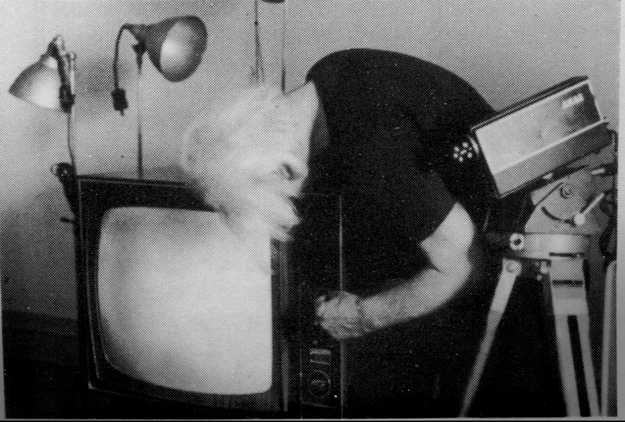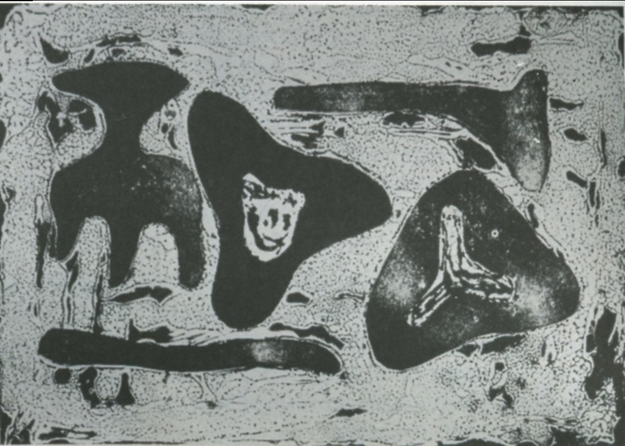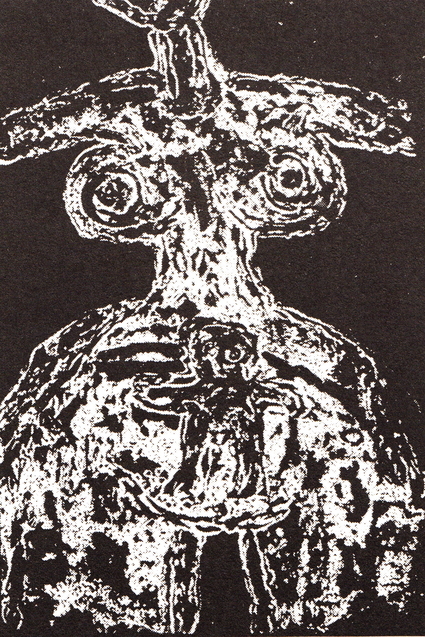As far as the tapes made by the first generation of Dutch video-artists are concerned, the work of videopioneer Livinus van de Bundt is about to be lost. Therefore at Montevideo in Amsterdam, a restoration and conservation project is being prepared. Also a large retrospective of the works of Livinus is being planned for exhibition in the VLEESHAL in Middelburg in 1986.
Livinus was the first artist in our country who utilized video techniques to create abstract images. His interest in video stemmed from an urge to mould light into a concrete form. This urge runs throughout his entire oeuvre as a main thread. After experimenting with paintings and graphics for a couple of years, technology started playing an increasingly important role, and he proved to be an ingenious autodidact.
Livinus, born in 1909, started painting at the age of 14. In 1937 he went to the Paris Atelier 17 for a year, an artcollege run by Bill Hayter, where a lot of new techniques were being experimented with. At Atelier 17 the spatial properties of the print were the central issue. Hayter maintained close touch with the surrealists and many famous modern artists visited the Atelier for prolonged periods. One of these artists was Picasso, whom Livinus befriended. In 1938, influenced by Picasso, the surrealists and the teachings of Bill Hayter, Livinus exhibited his abstract work: it consisted of layers of paper, featuring perforations caused by fire and other scorch - marks. Advers criticism made Livinus destroy the lot.
Dissatisfied with color and paint, he ceased painting a year later. I attained too little of the brilliance which I envisaged, as he once put it. For some time to come he would confine himself to graphic art, and try to show light in his prints through the contrast between black and white. His work from the prewar period after 1938 is figurative and not very revolutionary, but after the war he appears to have picked up on the trail where he had left off in 1938. This might have been influenced by Informal Art.
In 1957 the graphic work of Livinus was exhibited in the Stedelijk Museum. The style of his work is reminiscent of Picasso and the surrealists. Black convex figures are shown on a white background and the contours within these figures are shown as white lines. The simple shapes and the relief, attained by a combination of gravure and relief printing, make a lively print.
Toward the end of the fifties Livinus switched over to another means of expression: photography. He had become impressed by the abstract pictures of Pim van Os. Van Os made so-called Luminograms: abstract photos in which the main theme was the radiant, playful and mercurial properties of light.1) Livinus also made abstract photography, but according to a different technical procedure than Pim van Os. Having discovered the light transducing properties of certain glassfibers, Livinus used this phenomenon to write on light sensitive material. Lighter colors could be obtained by holding the lightbeam longer upon one spot. His photographic efforts can best be described as informal: the stainlike shapes are not immediately recognizable and some of the patterns seem to have been borrowed from nature. The outlines are sometimes sharp, sometimes blurred and the compositions are usually harmonious.
The next step in his work was to add motion to his images. He did this in many ways. For some objects he used his abstract photos as a basis, for instance in his continuous slideshows or with his Discovision. Discovision was a video-disc avant la lettre: an electronic cell, mounted onto the arm of a turnable, and scanning a disc, controlled a projector loaded with some hundred slides mounted in a second disc.2) The images, which Livinus produced with his so called Lumodynamical Machine, were reminiscent of his photographical work. The machine, of which two versions have existed, was an assembly of lenses, bulbs and electronic components, commanded by a keyboard. By pushing the appropriate buttons the composition projected on the screen could be changed again and again. And then there were the Chronopeintures, illuminated metal boxes, fitted with pieces of colored plastic and an observation- window. The plastic could be manipulated and would show the rigid geometrical shapes. The principle of the Chronopeinture loosely resembles that of the kaleidoscope.
Livinus was one of those who gave new impulses to the light art of the fifties. He was not inspired so much by his colleagues of those days, but saw himself more following the line of Bauhaus and Constructivism. He also felt allied to the Stijlgroep, as witnessed by the fact that he had planned to design, together with Rietveld, the lightning of the Amersfoort theater. However Rietveld died before the plan got under way.
This project is characteristic of the ideas which Livinus had about the application of his lightning apparatus. He thought them quite suitable for incorporation with architecture, and believed that they presented another opportunity to integrate architecture and the fine arts. This viewpoint is perhaps partly based on one of the theories of the Stijlgroep, that architecture was the synthesis of all branches of art.3) Furthermore, Livinus thought that light art incorporated into town-planning would be a good alternative to the usual visual racket and that it would improve the living climate in the city through it's therapeutical effects.
In the sixties Livinus started considering combining sound and image. He became interested in music through the activities of his son Jeep, who played drums in a band. He studied the relationship between light and color in combination with the rhythm of beat music. This culminated in Livinus building a lightshow for Jeep's band: it consisted of several colored spotlights, switching on and off to the beat of the drums.
In 1970, while at Intermedia in Vancouver, he started experimenting with video. He had been introduced to the medium in 1965 by Nam June Paik. The possibilities of electronic image manipulation, fast replay and the synchronous composing of image and electronic sound especially appealed to him. His tapes consist of series of abstract images changing in color and shape concordant to the music. In the tape Moirée made in 1972 together with Jeep, the picture distorts and discolors to the sound of psychedelic and melodious music as opposed to the tape Vijftig uit Twee (Fifty out of Two, 1978) which has the image changing to the beat of the drums. The image changes from a geometrical into an undulating pattern. Especially the transitions between the different patterns and the beautiful color combinations turn the tape into an esthetical experience.
Not only did Livinus see video as an efficient means to rework light and sound, but he also thought that the creative use of video would encourage his public to take a more critical stance towards the junk info on television and consequently inspire a new desire towards harmony.
Video would be the last medium for Livinus to mould light with. He once hoped that he would be able to employ computers, but his death in 1979 came too soon.
1) Carla van der Stap Biografie van Pim van Os, in: De geschiedenis van de fotografie, in monografieën en thema artikelen, Samson, Alphen a/d Rijn 1984
2) C. van Adrichem Video relatie beeld en geluid, bewegende licht- en geluidschilderingen van Livinus en Jeep van de Bundt, Leiden
3) Sergio Polano De Stijl/Architectuur = Nieuwe Beelding, in: De Stijl 1917-1931, Meulenhof/Landshoff, Amsterdam 1982
If you'd like to quote something: Rajandream, Marie-Adèle. "Livinus and the Light." Mediamatic Magazine vol. 0 # 0 (1985).
Translation: Marten Gerritsen


